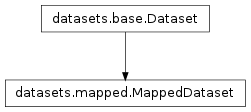This content refers to the previous stable release of PyMVPA.
Please visit
www.pymvpa.org for the most
recent version of PyMVPA and its documentation.
datasets.mapped
Module: datasets.mapped
Inheritance diagram for mvpa.datasets.mapped:

Mapped dataset
-
class mvpa.datasets.mapped.MappedDataset(samples=None, mapper=None, dsattr=None, **kwargs)
Bases: mvpa.datasets.base.Dataset
A Dataset which is created by applying a Mapper to the data.
Upon contruction MappedDataset uses a Mapper to transform the
samples from their original into the two-dimensional matrix
representation that is required by the Dataset class.
This class enhanced the Dataset interface with two additional
methods: mapForward() and mapReverse(). Both take arbitrary data
arrays (with matching shape) and transform them using the embedded
mapper from the original dataspace into a one- or two-dimensional
representation (for arrays corresponding to the shape of a single or
multiple samples respectively) or vice versa.
Most likely, this class will not be used directly, but rather
indirectly through one of its subclasses (e.g. MaskedDataset).
See also
Please refer to the documentation of the base class for more information:
Dataset
If samples and mapper arguments are not None the mapper is
used to forward-map the samples array and the result is passed
to the Dataset constructor.
| Parameters: |
- mapper (Instance of Mapper) – This mapper will be embedded in the dataset and is used and
updated, by all subsequent mapping or feature selection
procedures.
- data (dict) – Dictionary with an arbitrary number of entries. The value for
each key in the dict has to be an ndarray with the
same length as the number of rows in the samples array.
A special entry in this dictionary is ‘samples’, a 2d array
(samples x features). A shallow copy is stored in the object.
- dsattr (dict) – Dictionary of dataset attributes. An arbitrary number of
arbitrarily named and typed objects can be stored here. A
shallow copy of the dictionary is stored in the object.
- dtype (type | None) – If None – do not change data type if samples
is an ndarray. Otherwise convert samples to dtype.
|
|---|
-
O
Return samples in the original shape
-
mapForward(data)
Map data from the original dataspace into featurespace.
-
mapReverse(data)
Reverse map data from featurespace into the original dataspace.
-
mapSelfReverse()
Reverse samples from featurespace into the original dataspace.
-
mapper
-
samples_original
Return samples in the original shape
-
selectFeatures(ids, plain=False, sort=False)
Select features given their ids.
The methods behaves similar to Dataset.selectFeatures(), but
additionally takes care of adjusting the embedded mapper
appropriately.
| Parameters: |
- ids (sequence) – Iterable container to select ids
- plain (boolean) – Flag whether to return MappedDataset (or just Dataset)
- sort (boolean) – Flag whether to sort Ids. Order matters and selectFeatures
assumes incremental order. If not such, in non-optimized
code selectFeatures would verify the order and sort
|
|---|

